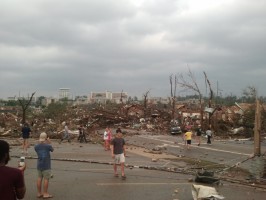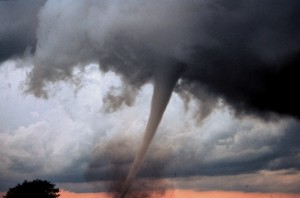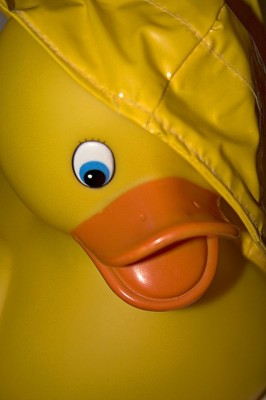File it under ‘Why didn’t I think of it sooner?“. Today, an experienced meteorologist (yes, a weatherman), makes his Dance Advantage debut to tell you about, what else? Storm safety.

The recent tornadoes in Tuscaloosa, AL, Joplin, MO and East Springfield, MA have vividly demonstrated that tornadoes can be deadly.
But there are a lot of things a teacher or dance studio owner can do to protect students in the event of severe weather.
I have been a meteorologist for 20 years and I have done every type of weather forecasting role there is, including being the smiling guy on TV with the funny hair. It was in my most recent TV role in Waco, Texas where the importance of storm safety was drilled into me. And that is to be expected, as Waco sits on the southern end of ‘Tornado Alley’, where most tornadoes in the U.S. form. Waco itself suffered one of the most destructive and deadly tornadoes in 1953, wiping out much of the downtown and killing 117 people. When Nichelle and I lived there, we had a tornado pass within ½ mile of our home one evening!
Storm safety is of utmost importance!
But, I am happy to say that preparing for such a dire situation is not as difficult as it seems. In fact, in discussing this topic over with my wife, we discovered that a dance studio actually has many features that would make it a reasonably safe place to be during a severe thunderstorm or tornado.
 My former chief meteorologist at KXXV in Waco, Andy Wallace had a wonderful acronym that he shared with me to help people (especially children) be able to find safety in nasty weather:
My former chief meteorologist at KXXV in Waco, Andy Wallace had a wonderful acronym that he shared with me to help people (especially children) be able to find safety in nasty weather:
D.U.C.K.
Pretty good, huh? And it even sounds like something you should do if something nasty is heading your way. Look out! Duck!!!
The letters stand for:
Downstairs.
Always be on the absolute lowest floor. If your studio has a basement AND you can accommodate everyone down there safely, all the better.
Underneath something.
Most studios have mats for tumbling, gymnastics, or other activities. Drag those out and instruct the children to get underneath them. If the children have thick coats in the cooler months, have them don these as well.
 Center of the building.
Center of the building.
Generally the interior hallway of the studio space. Your goal is to get as many walls between you and the outside as possible.
Keep away from windows.
Kind of relates to the previous precaution to stay away from outside walls, but broken glass flying through the air is to be avoided at all costs. This is one black mark against a dance space, but generally it’s inside the individual studios where the mirrors are mounted, not in the hallway outside.
Think through the D.U.C.K. steps above.
Can you think of a good location inside your building that meets all or at least most of these criteria? I’m sure nearly all can.
Honestly, covering with mats and padding will go a long way to make up for other shortcomings in the plan.
No-Stress Rehearsal
Once you have determined where you will go, you need to practice this with your staff and possibly with a full complement of students to make sure everything will go smoothly and that no teacher will panic when the actual threat occurs.
The worst thing that can happen (aside from a fatality of course) would be for a teacher to lose his or her cool while walking the students to their safe area within the studio. Students look to teachers to be a calming influence during a time like this, so even though you may be scared, try your best not to let it show.
More important precautions:
- Make sure the tornado safety plan is posted in a conspicuous location, much like a fire exit map, ideally in all studios.
- Invest in a NOAA weather radio with alert function
which can be programmed to go off when a severe thunderstorm or tornado warning is issued for your area.
- If you can, make sure your “safe area” is as free from glass as possible, including awards on the walls. This may mean a temporary removal of said awards during the heart of storm season in your area.
- Lastly, DO NOT waste time trying to open windows! The suggestion of opening windows to supposedly prevent a building from ‘exploding’ due to pressure differences is an old wives’ tale. It’s the winds that do damage in a storm, not pressure. Opening windows will get you closer to them (see letter K above) and rob you of valuable time to get to your safe place.
With a small amount of thought and planning, your dance studio can be a safe haven even during the nastiest of storms.
Have you ever been stuck at your dance studio during severe weather?
Leave a comment and tell your story.
Mark is a former TV meteorologist who appeared on-the-air nationally (MSNBC, CNBC, AccuWeather) and regionally in PA and TX. He now forecasts weather in the energy sector. He soothes his need to be silly in front of a viewing audience by entertaining his son and has been in countless community theater productions over the past 25-odd years. He admits he dances “like there’s no one watching”.

Dance Advantage welcomes guest posts from other dance teachers, students, parents, professionals, or those knowledgeable in related fields. If you are interested in having your article published at Dance Advantage, please see the following info on submitting a guest post. Read posts from guest contributors.

